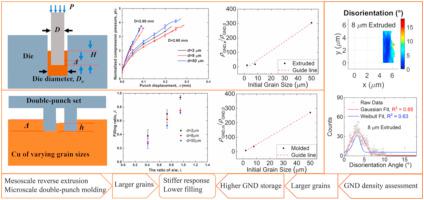International Journal of Machine Tools and Manufacture ( IF 14.0 ) Pub Date : 2021-08-11 , DOI: 10.1016/j.ijmachtools.2021.103795 Bin Zhang 1 , Andrew C. Meng 2 , W.J. Meng 1

|
Meso-/micro-scale metal forming offers problems in which the characteristic deformation length scale can approach the grain size of the material being formed. In this regime, the mechanical response of the deformed material exhibits various deviations from conventional continuum plasticity. This paper shows two such examples involving polycrystalline Cu with different grain sizes. In mesoscale axisymmetric reverse extrusion, Cu with a larger grain size requires a higher scaled pressure to extrude. In microscale double-punch molding, Cu with a larger grain size flows less into micron sized gaps as compared to Cu with a smaller grain size. In both cases, the trend expected from ranking of the bulk flow stress is reversed. To understand these phenomena, we quantitatively analyze crystallographic orientation data obtained from electron backscatter diffraction scans on thin material slices extracted from as-extruded and as-molded Cu specimens. The results show that, for both deformation geometries, Cu with the larger grain size stored more geometrically necessary dislocations under the same deformation geometry. The influence of grain size on geometrically necessary dislocation storage during forming offers a unified, structure-based rationale for the observed anomalous mechanical behavior. This storage is likely influenced by an interplay between the deformation geometry, the characteristic deformation length scale, and the grain size.
中文翻译:

微成形机械行为与连续尺度的偏差:几何上必要的位错存储观点
细观/微尺度金属成形提供了一些问题,其中特征变形长度尺度可以接近正在形成的材料的晶粒尺寸。在这种情况下,变形材料的机械响应表现出与传统连续塑性的各种偏差。本文展示了两个这样的例子,涉及不同晶粒尺寸的多晶铜。在中尺度轴对称逆向挤压中,晶粒尺寸较大的铜需要较高的尺度压力才能挤压。在微型双冲压成型中,与具有较小晶粒尺寸的 Cu 相比,具有较大晶粒尺寸的 Cu 较少地流入微米级间隙。在这两种情况下,总体流动应力排序所预期的趋势是相反的。要了解这些现象,我们定量分析了从挤压和成型铜样品中提取的薄材料切片的电子背散射衍射扫描获得的晶体取向数据。结果表明,对于两种变形几何形状,在相同的变形几何形状下,具有较大晶粒尺寸的 Cu 存储了更多的几何必要位错。晶粒尺寸对成形过程中几何必要位错存储的影响为观察到的异常机械行为提供了统一的、基于结构的基本原理。这种存储很可能受到变形几何形状、特征变形长度尺度和晶粒尺寸之间相互作用的影响。在相同的变形几何形状下,具有较大晶粒尺寸的 Cu 存储了更多的几何必要位错。晶粒尺寸对成形过程中几何必要位错存储的影响为观察到的异常机械行为提供了统一的、基于结构的基本原理。这种存储很可能受到变形几何形状、特征变形长度尺度和晶粒尺寸之间相互作用的影响。在相同的变形几何形状下,具有较大晶粒尺寸的 Cu 存储了更多的几何必要位错。晶粒尺寸对成形过程中几何必要位错存储的影响为观察到的异常机械行为提供了统一的、基于结构的基本原理。这种存储很可能受到变形几何形状、特征变形长度尺度和晶粒尺寸之间相互作用的影响。



























 京公网安备 11010802027423号
京公网安备 11010802027423号